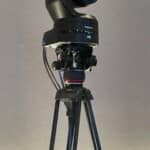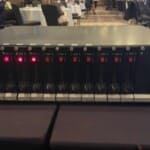Introduction
Hybrid meetings, combining physical and virtual elements, have become the cornerstone of modern event planning. In this dynamic landscape, event professionals, including conference organizers and event production companies, are increasingly looking for innovative ways to improve attendee experiences. One critical aspect of enhancing hybrid meetings is addressing language barriers through simultaneous interpretation. To harness the power of existing online meeting software like Zoom or Webex, event professionals can combine these platforms with essential equipment such as automatic PTZ cameras, infrared transmitters, and delegate receivers. In this comprehensive guide, we’ll explore how this equipment can seamlessly interface with online meeting platforms, highlighting the cost benefits, advantages, and disadvantages of this integrated approach.
The Power of Hybrid Meetings Using Simultaneous Interpretation
Hybrid meetings offer the best of both worlds, allowing participants to engage either in person or remotely, transcending geographical boundaries. However, one of the key challenges event professionals face is the need to provide effective communication across different languages in these events.
Integrating Equipment for Seamless Interpretation
To deliver a high-quality interpretation experience in a hybrid meeting setting, event professionals should consider the integration of specific equipment and technology:
- Automatic PTZ Cameras: Pan-Tilt-Zoom (PTZ) cameras play a crucial role in hybrid meetings. They are capable of capturing high-definition video and audio, which is essential for transmitting content from the physical meeting to both remote delegates and interpreters. These cameras can be strategically positioned in the physical event space to capture speakers, presenters, and any visual aids. The feed from these cameras can then be seamlessly integrated into the online meeting platform, ensuring that virtual attendees and interpreters, can see and hear the event’s content with clarity.
- Infrared Transmitters and Receivers: Infrared technology is indispensable for providing simultaneous interpretation to physically present attendees. Event professionals, like us at ISL can set up infrared transmitters in the room and provide delegate receivers to attendees who require interpretation services. Interpreters, logged in remotely, provide real-time translation through the built in language channels of a platform such as Zoom and this is captured by our technicians to broadcast within the physical room.attendees can select their preferred language channel on their delegate receivers. This technology ensures that attendees in the same physical space can access interpretation without disturbing others.
- Interface with Online Meeting Software: To seamlessly integrate equipment such as PTZ cameras, infrared transmitters, and delegate receivers with online meeting platforms like Zoom and Webex, event professionals should follow these steps:
- Camera Integration: Online meeting platforms often support the integration of external cameras. Event professionals can connect the PTZ cameras to their computers or hardware encoders, which then transmit the camera feed to the virtual meeting room. This allows remote attendees to access the live video feed, with options for language channels to access interpretation.
- Infrared System Integration: Infrared systems are usually standalone and do not require direct integration with online meeting software. We would deal with this by using individual PCs for each of the language channels and connecting these to an infrared transmitter. However, event professionals must ensure that both the interpretation and the primary audio are clear and in sync to provide a seamless experience for physically present attendees. Infrared systems are highly efficient in eliminating background noise and maintaining privacy, enhancing the interpretation experience.
What Does Simultaneous Interpretation for a Hybrid Event Look Like in Practice?
Take a recent example of a job we recently undertook at a London Hotel. The physical event took place on stage and was filmed with an automatic PTZ camera and broadcast via Zoom. We set up four PCs, each ‘listening’to one of the four languages being interpreted offsite using the Zoom interpretation facility. Each of these was connected to a channel on our infrared transmitter and then broadcast to the room in the normal way. See the photos below.
Advantages and Disadvantages of Integrating Simultaneous Interpretation into a Hybrid Event
The integration of equipment with online meeting software for simultaneous interpretation comes with its own set of advantages and disadvantages:
Advantages:
- Enhanced Clarity: The use of automatic PTZ cameras ensures high-quality audio and video transmission, allowing remote attendees to follow the event with clarity.
- Real-time Interpretation: Infrared transmitters and delegate receivers guarantee real-time interpretation for physically present attendees, enhancing their understanding and engagement.
- Cost Efficiency: While the initial investment in equipment may be significant, it can be used for multiple events, providing long-term cost benefits.
Disadvantages:
- Initial Investment: The integration of equipment requires an initial investment in PTZ cameras, infrared systems, and delegate receivers, which may not be feasible for smaller events.
- Technical Challenges: Setting up and maintaining the equipment can be technically challenging, and event professionals may require specialized personnel or support.
- Hybrid Meeting Complexity: As the equipment is primarily designed for in-person events, the management of simultaneous interpretation for both physical and virtual attendees can be complex.
Conclusion
Simultaneous interpretation is a powerful tool for enhancing hybrid meetings by breaking down language barriers and ensuring effective communication for all attendees, whether in person or joining virtually. By integrating essential equipment such as automatic PTZ cameras, infrared transmitters, and delegate receivers with online meeting platforms like Zoom or Webex, event professionals can provide a seamless multilingual experience.
While this integrated approach offers numerous advantages in terms of clarity and cost-efficiency, it does require careful planning and technical expertise. Event professionals should assess their specific needs and budget constraints to determine the most suitable solution for their events. Ultimately, the successful integration of equipment and online meeting software can significantly enhance the inclusivity and overall success of hybrid meetings in the rapidly evolving events industry.





